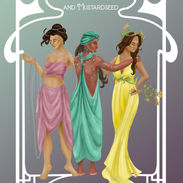
Callie Lythgoe
University of Arkansas
1st year MFA
Callie Lythgoe is originally from Utah, and recently moved to Arkansas to pursue a Masters' degree. She discovered costuming as a way to combine her long-time loves of theatre and fashion. Since then, she has found a passion and ambition for design and wants to take it as far as she can go.
A Midsummer Night’s Dream is a Shakespeare classic, and a treat to design. The play’s two sets of lovers, who can never be together in the real world, stumble into a different magic-filled realm in which their love is possible. I wanted to highlight the contrast between these worlds by placing the characters in the 1910s. This decade is home to one of my all-time favorite art styles, Art Nouveau, which often features beautiful women, flowing lines, and colorful pastels. Titania, Oberon, and the other fairies are done in this style. Our two fairy monarchs have strong, contrasting color palettes, which are echoed by their minions.
However, the lives of working and middle class people didn’t look like this at all, as they were experiencing the Industrial Revolution and WWI. And so, our lovers journey from their laborious lives into a world of art and fantasy. Their colors clearly indicate who belongs with who, but both sets use the muted colors of their ordinary lives. Theseus and Hippolyta, on the other hand, are of the ruling class. Their clothes, while beautiful, still play by real-world rules.
Another defining feature of this industrial time was the use of child laborers in factories, whose images came up again and again in my research. My mind immediately connected them to the comedic and lovable workers in the play, with the adult Bottom as their leader. I just love the idea of them deciding to put on a play to add a little fun to their lives, and seeing them perform the play itself would be quite sweet.







